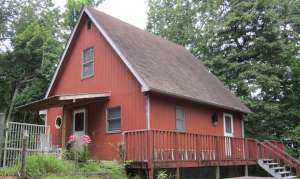VanderbiltThe family was founded by Cornelius
Vanderbilt (1794-1877), the fourth of nine children born to a Staten Island family of modest means. His great-great-great-grandfather, Jan Aertszoon van der Bilt (1620-1705), was a Dutch farmer from the village of De Bilt, Utrecht in the Netherlands who emigrated to the Dutch colony of New Netherlands as an indentured servant in 1650. Jan's village name was added to the Dutch "van der" (from the) to create "van der Bilt" which was evolved to
Vanderbilt when the English took control of New Amsterdam (now New York). Cornelius
Vanderbilt left school at the age of 11 and went on to build a shipping and railroad empire that, during the 19th century, made him one of the wealthiest men in the world.
The
Vanderbilt family owned land in Corwith Township, Michigan which was settled about 1875. When the
Vanderbilt-owned Michigan Central Railroad came through in 1880, the village of
Vanderbilt, Michigan was established. Although Cornelius
Vanderbilt always occupied a modest home, members of his family would use their wealth to build magnificent mansions. Shortly before his death in 1877,
Vanderbilt bequeathed US$1 million for the establishment of
Vanderbilt University in Nashville.
Members of the family dominated what has come to be known as the "Gilded Age", a period when
Vanderbilt men were the merchant princes of American life through their prominence in the business world and as patrons of the arts.
Some of Cornelius
Vanderbilt's offspring gained fame as successful entrepreneurs while several achieved prominence in other fields such as Alfred Gwynne
Vanderbilt (1877-1915), a noted horse breeder, who went down on the RMS Lusitania. Harold Stirling
Vanderbilt, (1884-1970), gained fame as a sportsman, winning the most coveted prize in yacht racing on three occasions, the America's Cup and his brother "Willie K" launched the
Vanderbilt Cup for auto racing. Cornelius
Vanderbilt IV (1898-1974) became an accomplished writer, newspaper publisher, and film producer. However, others made headlines as a result of drug and alcohol abuse and multiple marriages.
The Breakers, built 1892-1895 for Cornelius
Vanderbilt IICornelius
Vanderbilt had been awarded a gold medal by the United States government during the Civil War for donating his steamer "S.S.
Vanderbilt" to the Union forces. Inheritance of this medal became the symbol for the titular head of the
Vanderbilt family.
In 1855 Commodore Cornelius
Vanderbilt donated 8.5 acres (34,000 mē) of property to the Moravian Church and cemetery at New Dorp on Staten Island, New York. Later, his son William Henry
Vanderbilt donated a further 4 acres (16,000 mē). A plot was kept for the
Vanderbilt family in the Moravian Cemetery and a number of them are buried there in the family mausoleum including the family founder. Their mausoleum was redesigned in 1885 by architect, Richard Morris Hunt.
Frederick William
Vanderbilt's mansion on the Hudson RiverPresent-day economist John Kenneth Galbraith said that several generations of
Vanderbilts showed both the talent for acquiring money and the dispensing of it in unmatched volume, adding that they dispensed of their wealth for frequent and unparalleled self-gratification and very often did it with a forthright stupidity. Confirmation as to the validity of Galbraith's views is that only forty-eight years after the death of Cornelius
Vanderbilt one of his direct descendants died penniless. Within seventy years of his passing, the last of the ten great
Vanderbilt Fifth Avenue mansions in New York City had been torn down. In 1973, the first
Vanderbilt family reunion took place at
Vanderbilt University. Of the 120 descendants gathered there, not a single one of those in attendance was a millionaire, though many other members of the family are from their family inheritance.
The family's modern legacy includes
Vanderbilt University as well as
Vanderbilt Avenue in Midtown Manhattan, which runs alongside Grand Central Terminal, the New York City rail hub built by the
Vanderbilt family.

 1>
1>